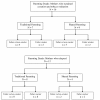Tobacco use patterns in traditional and shared parenting families: a gender perspective
- PMID: 20459752
- PMCID: PMC2881096
- DOI: 10.1186/1471-2458-10-239
Tobacco use patterns in traditional and shared parenting families: a gender perspective
Abstract
Background: Although researchers have focused on women's smoking during pregnancy and the postpartum period and the influence of household interactions on their tobacco reduction efforts, little attention has been given to parents' efforts to regulate smoking during the child-rearing years. The objective of this study was to examine how parenting young children and gender relations reflected in couple dynamics influence household tobacco use patterns and, specifically, women's tobacco reduction efforts.
Methods: As part of a longitudinal, grounded-theory study with 28 couples to examine the place of tobacco in the lives of new parents, each parent participated in one or two individual, semi-structured interviews during the first three years postpartum. Grounded theory methods and a gender relations framework were used to analyze transcribed data.
Results: Two different parenting styles that couples adhered to were identified. These parenting styles reflected performances of femininities and masculinities, and were associated with particular smoking patterns. Traditional parenting reinforced by women's alignment with emphasized femininities and men's alignment with hegemonic masculinities placed women with smoking partners at risk for relapse. Women's actions to be supportive partners facilitated couples' continued smoking. In shared parenting dyads, egalitarian practices tended to support successful transitions to smoke-free homes. Women's ability to exert more influence around family decision making, and the acceptance of new masculine identities associated with fatherhood were influential. In non-smoking dyads where the mother, father, or both reduced or stopped smoking, we observed a subtext of potential conflict in the event either the mother or father relapsed.
Conclusions: Decisions about tobacco use are made within relationships and social contexts that vary based on each individual's relationship to tobacco, divisions of domestic labour and childcare, and other activities that impact tobacco use. Sensitive approaches to tobacco reduction for women and men must be developed building on greater understanding of gender relations and how tobacco use is integrated in spousal and parental roles.
Figures
Similar articles
-
Couple dynamics during women's tobacco reduction in pregnancy and postpartum.Nicotine Tob Res. 2006 Aug;8(4):499-509. doi: 10.1080/14622200600789551. Nicotine Tob Res. 2006. PMID: 16920647
-
Men's constructions of smoking in the context of women's tobacco reduction during pregnancy and postpartum.Soc Sci Med. 2006 Jun;62(12):3096-108. doi: 10.1016/j.socscimed.2005.11.058. Epub 2006 Jan 18. Soc Sci Med. 2006. PMID: 16414163
-
"He's more typically female because he's not afraid to cry": connecting heterosexual gender relations and men's depression.Soc Sci Med. 2011 Sep;73(5):775-82. doi: 10.1016/j.socscimed.2011.06.034. Epub 2011 Jul 21. Soc Sci Med. 2011. PMID: 21807445
-
Gender, smoking and tobacco reduction and cessation: a scoping review.Int J Equity Health. 2014 Dec 12;13:114. doi: 10.1186/s12939-014-0114-2. Int J Equity Health. 2014. PMID: 25495141 Free PMC article.
-
Couple psychoeducation for new parents: observed and potential effects on parenting.Clin Child Fam Psychol Rev. 2010 Jun;13(2):164-80. doi: 10.1007/s10567-010-0066-z. Clin Child Fam Psychol Rev. 2010. PMID: 20390356 Review.
Cited by
-
Suffering in Silence: Impact of Tobacco Use on Communication Dynamics Within Vietnamese and Chinese Immigrant Families.J Fam Nurs. 2016 Feb;22(1):108-132. doi: 10.1177/1074840715618194. J Fam Nurs. 2016. PMID: 26717960 Free PMC article.
-
Smoking cessation and relapse-prevention interventions tailored for expectant and new fathers: protocol of a systematic review and network meta-analysis.BMJ Open. 2023 Oct 6;13(10):e071745. doi: 10.1136/bmjopen-2023-071745. BMJ Open. 2023. PMID: 37802607 Free PMC article.
-
Antenatal Care and Couples' HIV Testing in Rural Northern Uganda: A Gender Relations Analysis.Am J Mens Health. 2017 Jul;11(4):811-822. doi: 10.1177/1557988315602527. Epub 2015 Sep 23. Am J Mens Health. 2017. PMID: 26404474 Free PMC article.
-
Gender relations and health research: a review of current practices.Int J Equity Health. 2011 Dec 13;10:60. doi: 10.1186/1475-9276-10-60. Int J Equity Health. 2011. PMID: 22151578 Free PMC article.
-
Masculinity and Fatherhood: New Fathers' Perceptions of Their Female Partners' Efforts to Assist Them to Reduce or Quit Smoking.Am J Mens Health. 2015 Jul;9(4):332-9. doi: 10.1177/1557988314545627. Epub 2014 Aug 8. Am J Mens Health. 2015. PMID: 25106653 Free PMC article.
References
-
- Canadian tobacco use monitoring survey (CTUMS) http://www.hc-sc.gc.ca/hc-ps/tobac-tabac/research-recherche/stat/ctums-e... - PubMed
-
- Roseby R, Waters E, Polnay A, Campbell R, Webster P, Spencer N. Family and carer smoking control programmes for reducing children's exposure to environmental tobacco smoke. Cochrane Database Syst Rev. 2003;3(3):CD001746. - PubMed
Publication types
MeSH terms
Grants and funding
LinkOut - more resources
Full Text Sources
Medical
Research Materials


